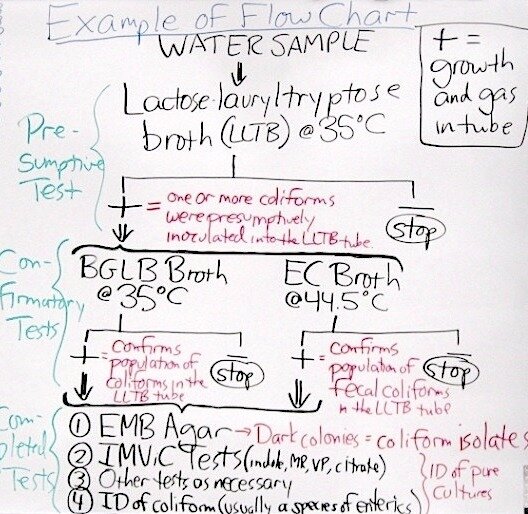 |
Revised May 30, 2013
Some important points are reviewed here.
Coliforms are considered indicator organisms in food and water analysis not because they are "bad" in themselves, but because they are often associated with potential health problems. Two examples:
The basic definition one encounters about coliforms is that they are gram-negative rods that ferment lactose rapidly with the production of gas – i.e., insoluble gas that is detectable in a Durham tube. A more precise definition would specify that they can grow and show gas production from fermentation in Lactose Lauryl Tryptose Broth and Brilliant Green Bile Broth at 35°C. Those which additionally do so in EC Broth at 44.5°C belong to the subset of coliforms called "fecal coliforms."
With these characteristics in mind, coliforms happen to be easy to detect with the appropriate selective-differential media in the enrichment process. These media tend to inhibit gram-positive bacteria, and the presence of coliforms (among the other organisms which would also be present) is suggested by gas from lactose fermentation in the Durham tube.
The enrichment media in the following table increase in selectivity for the desired organisms from left to right. We never expect a pure culture in any enrichment medium (selective or otherwise), so the subsequent isolation (on EMB Agar, below) is important as in any enrichment-isolation procedure, as noted in Experiment 11. For a tube which shows growth and gas, suggesting the presence of coliforms, all it might have taken for a population of coliforms to develop in the tube could have been just one coliform cell in the inoculum. Cells of non-coliforms may or may not be able to grow in any of these media. However, one way or another in the enrichment and subsequent isolation process, they will be eliminated from consideration.
| Organisms in the water sample that may grow in LLTB. | Note that growth with gas indicates the possible presence of coliforms in LLTB and is confirmatory in the other two media that are inoculated from LLTB. | ||
| LLTB | BGLB | EC Broth at 44.5°C | |
| The true coliforms ("fecal" and others). | growth & gas | growth & gas | growth & gas only for fecal coliforms |
| Occasional strains of Bacillus and Clostridium that ferment lactose to acid and gas ("false coliforms"). | growth & gas | no growth | no growth |
| Some Gram-negative bacteria other than coliforms. (Pseudomonas may persist in any of these media.) | growth with no gas | growth of fewer kinds (no gas) | growth of still fewer kinds (no gas) |
| Some rare Gram-positive bacteria other than those in the second row. | growth with no gas | no growth | no growth |
With the use of EMB Agar (which contains lactose and gram-positive inhibitors) in the isolation process, coliforms are detected by their acidic colonies from which isolates are chosen for identification by the use of the appropriate differential media.
One must realize that coliforms do not constitute a discrete taxonomic group. Usually they are ultimately identified as various species of enteric bacteria of the genera Escherichia, Enterobacter, Klebsiella and Citrobacter, and a coliform isolate from an EC Broth enrichment is usually identified as E. coli. That does not mean that these genera are to be therefore categorized as coliforms! Out in the real world, one may encounter many "exceptional" strains of these genera that do not conform to the definition of coliform. Many pathogenic E. coli strains do not ferment lactose, and it is sometimes very difficult to differentiate them from Shigella. Also, most strains of Citrobacter (such as the one we use in Experiment 14A) very weakly attack lactose and may be initially confused with Salmonella when isolations are made from clinical or natural samples. So, considering the absolute definition of this non-taxonomic term, there can be no such thing as a non-lactose-fermenting coliform.
 |